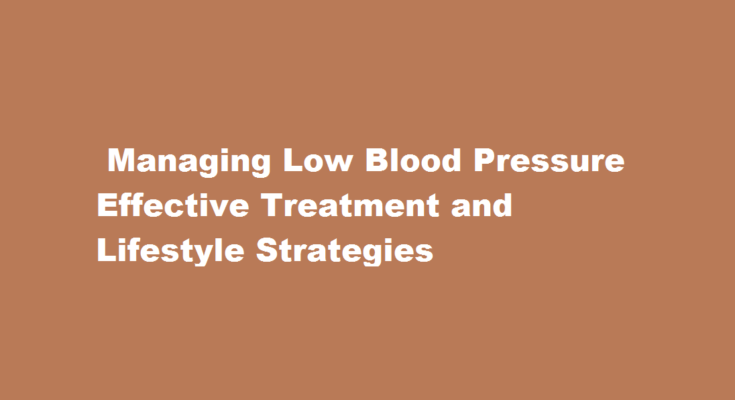Introduction
Low blood pressure, medically known as hypotension, can cause symptoms such as dizziness, fatigue, and fainting. While it is often considered less concerning than high blood pressure, it can still affect a person’s quality of life. Fortunately, there are several effective treatment options and lifestyle strategies available to manage low blood pressure and alleviate its symptoms. In this article, we will explore these approaches and provide valuable insights for individuals experiencing low blood pressure.
Understanding Low Blood Pressure
Blood pressure is the force exerted by blood against the walls of the arteries. A blood pressure reading consists of two numbers: systolic pressure (the higher number) and diastolic pressure (the lower number). Low blood pressure is typically defined as a reading below 90/60 mmHg. However, it is important to note that what is considered low can vary from person to person, as some individuals naturally have lower blood pressure without experiencing symptoms. It is when low blood pressure leads to noticeable symptoms and affects daily life that treatment may be necessary.
Treatment Options for Low Blood Pressure
- Increase Fluid Intake Staying adequately hydrated can help raise blood volume, thus improving blood pressure. Drinking sufficient water throughout the day and consuming electrolyte-rich fluids, such as sports drinks or coconut water, can be beneficial.
- Increase Salt Intake Sodium helps retain fluid in the body, which can help increase blood pressure. However, it is essential to consult a healthcare professional before significantly increasing salt intake, especially for individuals with certain health conditions like kidney problems or hypertension.
- Wear Compression Stocking Compression stockings help prevent blood from pooling in the legs by exerting pressure on the blood vessels. This promotes blood flow to vital organs and can alleviate symptoms associated with low blood pressure.
- Medications In severe cases, healthcare providers may prescribe medications to raise blood pressure. These medications may include fludrocortisone, midodrine, or non-selective alpha agonists. These drugs work by constricting blood vessels or increasing fluid retention.
Lifestyle Strategies for Managing Low Blood Pressure
- Exercise Regularly Engaging in regular physical activity can help improve blood circulation and raise blood pressure. Focus on exercises that involve rhythmic movements and incorporate strength training to build muscle tone. However, individuals with low blood pressure should consult a healthcare professional before starting or modifying an exercise routine.
- Avoid Prolonged Standing or Sitting Standing or sitting for extended periods can lead to blood pooling in the legs and exacerbate symptoms. If your work requires prolonged sitting or standing, take breaks to move around and stretch at regular intervals.
- Eat Frequent, Small Meals Consuming smaller meals throughout the day can help prevent a sudden drop in blood pressure after eating. Focus on a balanced diet that includes whole grains, lean proteins, fruits, and vegetables.
- Limit Alcohol and Caffeine Intake Alcohol and caffeine can cause blood vessels to expand, resulting in a drop in blood pressure. Moderation is key, and it’s advisable to limit alcohol and caffeine consumption, especially if you experience symptoms of low blood pressure.
Frequently Asked Questions
How do you raise low blood pressure in a hurry?
Drink a caffeinated beverage: Caffeinated foods and beverages like coffee, tea, and dark chocolate cause an increase in heart rate and a temporary spike in blood pressure—especially for people who do not typically consume them.
What is a dangerously low blood pressure?
What is hypotension? Hypotension is abnormally low blood pressure (lower than 90/60 mm Hg). If your blood pressure gets too low, it can cause dizziness, fainting or death. Low blood pressure is not a condition that is usually treated except if it occurs in the elderly or occurs suddenly.
Conclusion
Managing low blood pressure involves a combination of lifestyle modifications and, in some cases, medical interventions. By increasing fluid and salt intake, wearing compression stockings, exercising regularly, and adopting healthy eating habits, individuals can effectively manage low blood pressure and reduce associated symptoms. It is crucial to consult a healthcare professional for personalized advice and guidance, especially for individuals with underlying medical conditions. Taking proactive steps towards managing low blood pressure can significantly improve one’s overall well-being and quality of life.
Read Also : Gaining Control Over OCD Effective Strategies for Managing Obsessive-Compulsive Disorder



